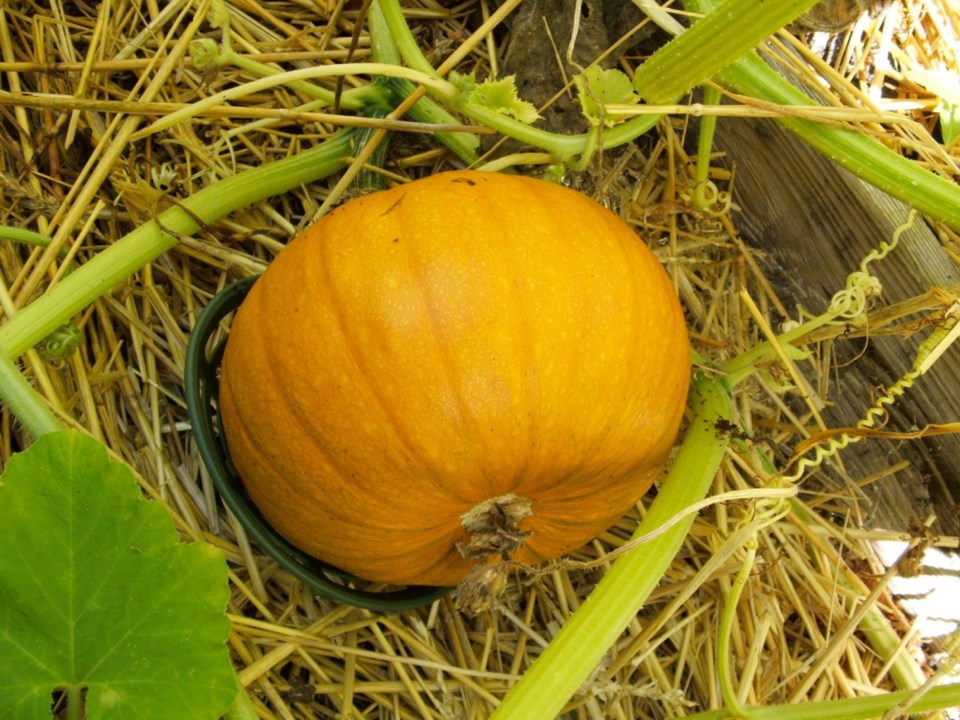Dear Helen: Some of my pumpkins turned orange almost alarmingly early this summer — about mid-July. Will they be all right? Should they be harvested early?
L.P.
My Small Sugar pumpkins were fully coloured at about the same time. They’ll be fine. As the vines begin to die back, watch the stems. Once a stem is shrivelled and dry, it can no longer work to feed the fruit. At that point the stem should detach easily from the vine.
To prepare pumpkins for successful storing, I wash them well and “cure” them by placing the fruits either in the sun or by a heat source indoors, depending on the weather, for about 10 days to further harden the skins. Pumpkins will store well for up to three months in cool, dry conditions, such as in an attic. I place mine in baskets just inside the north-facing front door, where temperatures stay cool in fall and winter.
It’s important to retain stems on pumpkins and winter squash, and not to use the stems as carrying handles. Once a stem breaks off, the pumpkins or squash won’t store well.
Dear Helen: Have you ever tried growing potatoes in pots? If you have, how has it worked?
A.D.
I did grow a few potato plants in large patio pots last year. I can’t say the plantings were wildly productive.
This year, I have potatoes growing in two different types of planters. Three are polypropylene grow bags from West Coast Seeds. The other is a durable recycled fabric bag rather like industrial-strength canvas. I came across it one Saturday morning in the spring at a farmers’ market. I’ll be reporting on the harvest from these planters later. The vines are still green.
Next year, I plan to duplicate another above-ground potato growing method I observed early this summer in a large community garden in Duncan. One of the plots had potato plants growing out of sturdy cardboard boxes set on the ground and tied around with rope. The box bottoms were opened, with the closing flaps spread outward on the ground.
I like this no-cost, use-what’s-on-hand approach, and the bototmless enclosure would make it possible to reach underneath in search of new potatoes without disturbing the planting too much. Once potato plants start to flower, a few early tubers usually will have formed.
Dear Helen: Which produces a better yield — purchased bean seeds or seeds saved from one’s own garden plants?
K.W.
Because so many variables are involved, there’s no definitive answer to your question.
If seeds saved from garden plants are selected purposefully and with care, they should yield the best possible results in your garden’s conditions.
First, save seeds only from varieties that are not hybrids. Then, in the case of each open-pollinated (non-hybrid) plant, determine the qualities you most desire. Those most commonly considered are general plant health, ease of cultivation, earliness, and the quality and quantity produced of the desired vegetable or flower.
As a planting develops, mark out in some way the most robust, healthy plants. One way is to loosely tie coloured yarn around the stems. Among these chosen plants, save seeds from the ones that deliver the other qualities you desire.
Beans are among the easiest plants for seed saving, because cross-pollination is not usually a problem. The flowers most often self-pollinate before opening. An exception is the runner bean, which requires pollination by bees or some other flying creature to form pods and seeds.
Still, to be sure to keep the variety you want to save pure, it is recommended to keep bean varieties separated by about 46 metres.
Harvest pods from the selected plants when they have dried and turned brown. Spread them out in a dry, warm place indoors for 10 days to two weeks before shelling them and storing the seeds in a dry, dark, uniformly cool place, preferably in paper bags. Avoid using airtight containers for pea and bean seeds. Label the seeds with the variety name and the year.
Over several years of careful selecting, you should end up with seeds that are thoroughly acclimatized to the soil and growing conditions of your garden. They should give you the most easy-growing, bountiful plantings possible.



